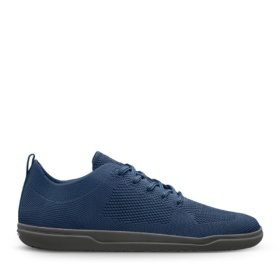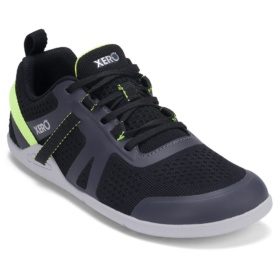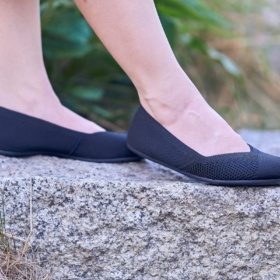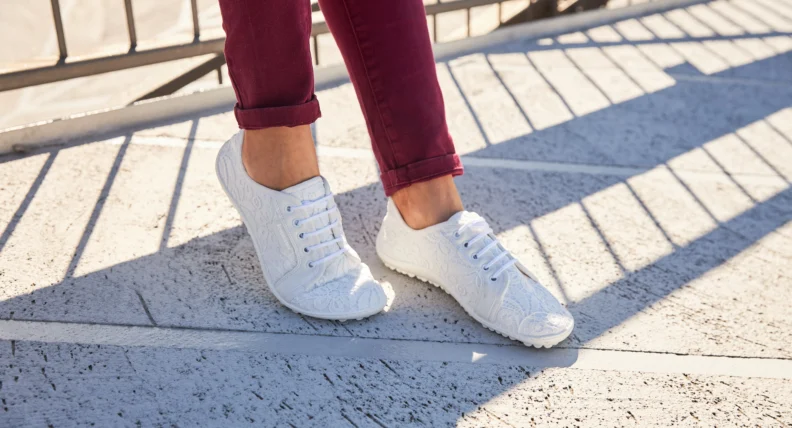Your feet carry you through life—literally. Yet most of us spend zero time thinking about whether our shoes actually support healthy foot function. If your feet ache after a day on your feet or you’re dealing with bunions, plantar fasciitis, or general foot fatigue, your footwear might be working against you rather than with you.
What makes a shoe “healthy”?
Healthy shoes share key characteristics that allow your feet to function the way nature intended. Your feet evolved over millions of years to walk, run, and climb without any footwear at all. Modern conventional shoes often interfere with that natural design.
The foot-shaped toe box
Your toes should spread naturally when you walk. Yet most conventional shoes taper to a narrow point, squeezing your toes together like sardines in a can.
A truly foot-shaped toe box is widest at the toes, not at the ball. When your toes can spread, they provide a stable base for balance and proper weight distribution. Research from Harvard Medical School and Hong Kong Polytechnic University found that runners who gradually transitioned to minimalist footwear with wide toe boxes showed an 8.8% increase in intrinsic foot muscle volume after six months—their feet literally got stronger just from having room to move naturally.
Zero drop (flat from heel to toe)
“Zero drop” means the heel and forefoot sit at the same height. Most conventional shoes have an elevated heel—sometimes by an inch or more—which tilts your body forward and forces your muscles and joints to compensate.
Zero-drop shoes let your body align naturally. Your posture improves, your calves stretch properly, and your stride becomes more efficient. A 2025 systematic review found that minimalist footwear combined with gait retraining significantly promoted forefoot striking, reducing repetitive stress on your feet and decreasing injuries like plantar fasciitis and patellofemoral pain syndrome.
Flexible, thin sole
Your feet contain 33 joints, 26 bones, and over 100 muscles, tendons, and ligaments. They’re designed to bend, flex, and adapt to uneven terrain. Stiff, thick soles prevent that natural movement and numb the sensory feedback your feet need to adjust with each step.
Barefoot shoes feature thin, flexible soles (typically 3-10mm) that let you feel the ground beneath you. This enhanced feedback encourages more careful, controlled movement. According to research on barefoot footwear, transitioning to minimalist shoes often increases ankle mobility and improves lower limb muscle mass, contributing to overall foot resilience.
Lightweight design
Heavy shoes force your muscles to work harder with every step. Over thousands of steps per day, that extra weight adds up to significant fatigue. Barefoot shoes typically weigh under 200g per shoe, reducing the energy cost of walking while allowing your feet to move more naturally.
No arch support
This might sound counterintuitive, but traditional arch support can cause foot muscle atrophy. When a shoe holds your arch up for you, the muscles that should be doing that job get lazy and weak. Remove the support suddenly, and those weakened muscles can’t handle the load—potentially leading to plantar fasciitis, stress fractures, and Achilles tendonitis.
Barefoot shoes let your arch do its job, strengthening the muscles over time. (More on safe transitioning in a moment.)
What’s wrong with conventional shoes?
Most mainstream footwear prioritizes fashion and cushioning over function. Here’s how conventional shoes can undermine your foot health:
Narrow toe boxes squeeze toes together, which can lead to bunions (hallux valgus), hammertoes, and neuromas. Your big toe especially needs room to push off properly during your stride.
Elevated heels—even in “flat” shoes—shorten your calf muscles over time, tighten your Achilles tendon, and throw off your body’s natural alignment. This puts extra stress on your knees, hips, and lower back.
Excessive cushioning might feel comfortable initially, but it prevents your feet from sensing the ground. This sensory deprivation reduces your body’s ability to make subtle adjustments. While cushioning can reduce impact forces, research shows its long-term effects on natural foot function are still unclear.
Stiff, rigid soles prevent your feet from flexing naturally. When your foot can’t move through its full range of motion, the muscles, tendons, and ligaments don’t get the workout they need to stay strong and flexible.
Built-in arch support does the work your muscles should be doing, weakening your natural arch support system over time.
How to evaluate shoes for foot health
When shopping for healthier footwear, try these tests:
The twist test: Hold the shoe by the heel and toe and try to twist it. It should twist easily, showing the sole is flexible enough for natural foot movement.
The bend test: Try to fold the shoe in half. It should bend easily at the ball of the foot.
The width test: Look inside at the widest part. Is it at the toes (good) or at the ball of the foot (not ideal)? Place the shoe on the ground and look from above—does it roughly match the shape of a foot?
The drop test: Place the shoe on a flat surface and look from the side. Is there visible heel elevation? Even a small lift affects your posture and gait.
The weight test: Pick up the shoe. Does it feel surprisingly light or hefty? Lighter is generally better for allowing natural movement.
Making the transition to barefoot shoes
If you’ve spent years in conventional footwear, your feet have adapted to that environment. Your foot muscles may be weak, your calves tight, and your gait patterns ingrained.
Jumping straight into barefoot shoes for eight hours a day is like going from the couch to running a marathon. A systematic review found that after a 10-week transition, some minimalist shoe users showed significantly higher occurrence of bone-marrow edema on MRI compared to traditional shoe users, indicating potential injury risk during rapid adaptation.
The solution? Go slow. Research suggests a safe transition requires 6-12 months for proper arch strengthening, not the 2-3 weeks many people attempt.
Start by wearing barefoot shoes for short periods (30 minutes to an hour) and gradually increasing. Walk barefoot at home as much as possible to wake up those foot muscles. Incorporate simple foot exercises into your daily routine—toe spreads, picking up objects with your toes, single-leg balance. Alternate between your old shoes and new ones during the transition period, and listen to your body. Some mild muscle soreness is normal, but sharp pain is a red flag.
For detailed guidance on transitioning safely, check out our complete guide to transitioning from regular shoes to barefoot shoes.
Choosing barefoot shoes for different needs
Not all barefoot shoes are created equal. Here’s what to consider:
For everyday casual wear: Look for versatile styles with good breathability. Groundies offers stylish everyday barefoot shoes that work for average to slightly wider feet, while Freet specializes in models that accommodate wide and very wide feet.

Groundies Active Knit Navy

Freet Flex
For athletic activities: Choose shoes with slightly more grip and durability. The Xero Shoes line includes excellent athletic options backed by a 5,000-mile sole warranty, with models suitable for both average and wide feet.

Xero Shoes Prio Neo Men Asphalt/Black
For work and professional settings: Barefoot doesn’t have to mean sporty—many brands now offer professional-looking options in neutral colors.

Xero Shoes Phoenix Knit Black Women
For kids: Children’s feet are still developing, making proper footwear even more critical. Look for flexible soles, wide toe boxes, and lightweight designs. Browse our kids’ collection for age-appropriate options that support healthy foot development.

Tikki NIDO Fox
For specific foot widths: If you have particularly wide feet, prioritize brands known for generous widths. Very narrow feet might need different considerations—contact us for personalized recommendations.
Supporting your foot health journey
Beyond choosing the right shoes, a few accessories and practices can support your transition:
Barefoot socks: Traditional socks can bunch up in barefoot shoes. Consider toe socks that let each toe move independently or thin, breathable athletic socks.
Transitional insoles: If the transition feels challenging, temporary use of minimal insoles can provide a bridge. Remove them gradually as your feet strengthen.
Foot exercises: Regular strengthening and mobility work accelerates your transition and prevents injury. Spend time barefoot, practice picking up objects with your toes, and work on single-leg balance.
Give your feet the freedom they deserve
Choosing shoes for healthy feet isn’t complicated—it just requires rethinking what shoes should do. Instead of controlling, cushioning, and supporting your feet, healthy shoes allow them to move, sense, and strengthen naturally.
The benefits extend beyond your feet. Better foot function often leads to improved posture, reduced knee and back pain, and a more efficient, comfortable stride. Many people report feeling more grounded and connected to their movement.
Ready to give your feet the freedom they deserve? Browse our collections for women, men, and children to find barefoot shoes that fit your lifestyle. Remember—take it slow, listen to your body, and give yourself time to adapt. Your feet have been waiting their whole life to move the way nature intended. 🦶
